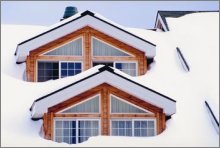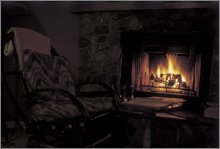How to Winterize Your Home:
The 10 Key Steps for Your Health and Wellbeing
by www.SixWise.com
After pumpkins and apple cider come snow showers and icicles,
and while you're preparing your mind for the upcoming holidays,
it's important to prepare
your home for the coming winter weather as well.
|

Don't wait to inspect your home's gutters, ceiling
and windows. Once it snows, it will be too late!
|
If you don't, you risk higher heating bills and possibly
some expensive repairs come spring. As soon as you feel the
air getting chilly, it's time to complete the list below.
1. Clean Your Gutters
Fallen leaves can easily clog your gutters, causing water
to back up, freeze and possibly seep into your home. First
remove any debris from the gutters, then rinse them well with
a hose. As you do so, check for any leaks, and make sure the
downspouts carry water away from your house, so the outpour
doesn't leak into your foundation.
2. Do a "Pre-Winter Cleaning"
Many of us already do spring
cleaning of our homes, but a thorough cleaning prior to
winter is also important. Keep in mind that during a winter
cleaning you will not be able to vent your windows for fresh
air, so it's very important to use only natural cleaning supplies
that won't add potentially toxic chemicals into your
home's air.
When it comes to cleaning tools, Sixwise.com highly recommends
the PerfectClean
line of terry-cloths, dusters and mits -- the same tools
used by leading hospitals, hotels, and other organizations
that depend on environments that are clean down to the biological
level.
Rather than just pushing dust and dirt around, or worse,
stirring it up into the air, all PerfectClean products are
made with positively charged ultramicrofibers that pick up
everything in their path -- including the biological and toxic
contaminants that no other cleaning tool or solution can touch.
As for cleaning supplies, most commercial cleaners are toxic
and contain harsh chemicals that are poisonous if inhaled
or spilled on the skin. If you're looking for a top-notch
cleaning line that's completely safe for you and the environment,
we also highly recommend the EnviroRite
line of non-toxic cleaning products, which contain no
hazardous ingredients, petrochemicals, perfumes, dyes or animal
byproducts.
3. Check Your Insulation
Hot air rises, so adequate insulation in your attic is crucial
to save money on your heating bills.
"If you go into the attic and you can see the ceiling
joists you know you don't have enough, because a ceiling joist
is at most 10 or 11 inches," says Danny Lipford, host
of the TV show "Today's Homeowner."
Generally, you want at least 12 inches of attic insulation
to keep your home warm.
4. Disconnect and Drain Hoses and Sprinkler Systems
You must disconnect, and drain, hoses, outdoor faucets and
sprinkler systems before the first freeze of the season. Otherwise,
the pipes could easily burst, causing major damage.
5. Keep Out Cold Air
Drafts from cold winter air are said to account for 10 percent
of your heating bill. To keep cold air out, use weather-stripping
and caulk around your windows and doors. If your windows are
particularly drafty, and you aren't ready to buy new windows,
inexpensive window insulation kits are available at home improvement
stores. The key areas to inspect for leaks, according to Lipford,
are:
-
Around door and window frames
-
Around exterior openings including utility outlets, phone
lines, outside plumbing faucet, vents and fans
-
Around heating and/or air conditioning
-
Around room air conditioners
-
At corners formed by siding
-
Openings around drain pipes in bathroom and kitchen
6. Consider a Programmable Thermostat
|

By caulking your windows and doors to keep drafts out,
you can turn down your thermostat, save money on your
heating bill, and still stay cozy and warm.
|
It's most efficient to heat your home up a little after you've
been out than to simply keep the heat up all the time. Programmable
thermostats allow you to keep the heat down while you're out
or sleeping, then turn it up shortly before you get home from
work or wake up in the morning. Even small temperature changes
can make a big difference. According to Lipford, for every
degree that you lower the temperate in your home, your heating
bill will go down about 2-3 percent.
7. Take Care of Your Furnace
Replace or clean your dirty furnace filters and have a professional
inspect your furnace to make sure it's working properly. If
necessary, have your ducts cleaned as well.
8. Prepare Your Hot Water Heater
Hot water makes up an estimated 14 percent of your utility
bill. You can help to keep your water hot by wrapping a water-heater
blanket around your water
heater and insulating your water pipes.
9. Inspect Your Roof
Minor damage, such as missing or cracked shingles or bare
spots, can lead to much more extensive damage if water leaks
in. If you spot broken or curling shingles, or bare spots
in the granular coating, you should repair them now.
10. Reverse Your Ceiling Fan
In the winter, ceiling fans can keep hot air down toward
the floor instead of hovering near the ceiling. They should
run clockwise, on low, for maximum efficiency in the winter.
Recommended Reading
The
Five Home Construction Materials that Pose the Highest Health
Risk to You
Which
Home Renovations are Your Best Investments?
Sources
DannyLipford.com
CBSNews.com